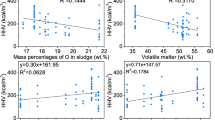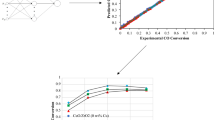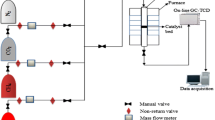Abstract
Thermo-catalytic methane decomposition is a prospective route for producing COx free hydrogen. In this study, Bayesian regularization and Levenberg-Marquardt trained multilayer perceptron neural networks were employed in predictive modeling of hydrogen production by thermo-catalytic methane decomposition. Based on the non-linear relationship between the reaction temperature, weight of the catalysts, time of stream, calcination temperature, calcination time, specific volume, and the hydrogen yield, the various topology was configured for the neural network and tested to determine the artificial neuron that would result in the best model performance. The Levenberg-Marquardt trained neural network displayed the best performance with the model topology of 7–16-1 compared with the Bayesian regularization trained network. The model topology of 7–16-1 represents the input units, hidden neuron, and the output unit. The predicted hydrogen yield by the 7–16-1 configured neural network was in strong agreement with the observed value, evidenced by the coefficient of determination (R2) of 0.953 and mean square error of 0.03. A predicted hydrogen yield of 86.56 vol.% was obtained at the reaction temperature of 700 °C, 0.5 g catalyst weight, calcination temperature of 600 °C, calcination time of 240 min, catalyst specific surface area of 24.1 m2/g, the pore volume of 0.03 cm3/g, and 160 min time on stream which is at proximity with the observed value of 84 vol.%. The sensitivity analysis revealed that all the input parameters have varying levels of importance on the model output. However, the intrinsic properties of the catalysts (specific surface area, and the pore volume) have the most significant influence on the predicted hydrogen yield.








Similar content being viewed by others
References
Syed Muhammad AF, Awad A, Saidur R et al (2018) Recent advances in cleaner hydrogen productions via thermo-catalytic decomposition of methane: admixture with hydrocarbon. Int J Hydrog Energy 43:18713–18734. https://doi.org/10.1016/j.ijhydene.2018.08.091
Ashik UPM, Wan Daud WMA, Abbas HF (2015) Production of greenhouse gas free hydrogen by thermocatalytic decomposition of methane - a review. Renew Sust Energ Rev 44:221–256. https://doi.org/10.1016/j.rser.2014.12.025
Ayodele BV, Khan MR, Cheng CK (2016) Greenhouse gases mitigation by CO2 reforming of methane to hydrogen-rich syngas using praseodymium oxide supported cobalt catalyst. Clean Techn Environ Policy 19:1–13. https://doi.org/10.1007/s10098-016-1267-z
Seo HO (2018) Recent scientific progress on developing supported Ni catalysts for dry (CO2) reforming of methane. Catalysts 8:16–22. https://doi.org/10.3390/catal8030110
Iulianelli A, Liguori S, Wilcox J, Basile A (2016) Advances on methane steam reforming to produce hydrogen through membrane reactors technology: a review. Catal Rev Sci Eng 58:1–35. https://doi.org/10.1080/01614940.2015.1099882
Hossain MA, Ayodele BV, Ong HR et al (2020) Thermo-catalytic conversion of greenhouse gases (CO2 and CH4) to CO-rich hydrogen by CeO2 modified calcium iron oxide supported nickel catalyst. Int J Energy Res n/a. https://doi.org/10.1002/er.5346
Su M, Khine S, Chen L et al (2013) Syngas production by catalytic partial oxidation of methane over ( La 0. 7 A 0. 3 ) BO 3 ( A [ Ba , Ca , Mg , Sr , and B ] Cr or Fe ) perovskite oxides for portable fuel cell applications. Int J Hydrog Energy 8
Ayodele BV, Cheng CK (2015) Process modelling, thermodynamic analysis and optimization of dry reforming, partial oxidation and auto-thermal methane reforming for hydrogen and syngas production. Chem Prod Process Model 10:211–220. https://doi.org/10.1515/cppm-2015-0027
Ursua A (2012) Water electrolysis : current status and future trends. In: Proceedings of the IEEE
Sikarwar VS, Zhao M, Fennell PS et al (2017) Progress in biofuel production from gasification. Prog Energy Combust Sci 61:189–248. https://doi.org/10.1016/j.pecs.2017.04.001
Self SJ, Reddy B V, Rosen M a (2012) Review of underground coal gasification technologies and carbon capture. Int J Energy Environ Eng 3:16. https://doi.org/10.1186/2251-6832-3-16
Goto Y, Hisatomi T, Wang Q et al (2018) A particulate Photocatalyst water-splitting panel for large-scale solar hydrogen generation. Joule 2:509–520. https://doi.org/10.1016/j.joule.2017.12.009
Abbas HF, Wan Daud WMA (2010) Hydrogen production by methane decomposition: a review. Int J Hydrog Energy 35:1160–1190. https://doi.org/10.1016/j.ijhydene.2009.11.036
Li Y, Li D, Wang G (2011) Methane decomposition to COx-free hydrogen and nano-carbon material on group 8-10 base metal catalysts: a review. Catal Today 162:1–48. https://doi.org/10.1016/j.cattod.2010.12.042
Timmerberg S, Kaltschmitt M, Finkbeiner M (2020) Hydrogen and hydrogen-derived fuels through methane decomposition of natural gas – GHG emissions and costs. Energy Convers Manag X 7:100043. https://doi.org/10.1016/j.ecmx.2020.100043
Hasnan NSN, Timmiati SN, Lim KL et al (2020) Recent developments in methane decomposition over heterogeneous catalysts: an overview. Mater Renew Sustain Energy 9:1–18. https://doi.org/10.1007/s40243-020-00167-5
Keipi T, Tolvanen KES, Tolvanen H, Konttinen J (2016) Thermo-catalytic decomposition of methane: the effect of reaction parameters on process design and the utilization possibilities of the produced carbon. Energy Convers Manag 126:923–934. https://doi.org/10.1016/j.enconman.2016.08.060
Zhang W, Ge Q, Xu H (2011) Influences of reaction conditions on methane decomposition over non-supported Ni catalyst. J Nat Gas Chem 20:339–344. https://doi.org/10.1016/S1003-9953(10)60205-8
Koschwitz D, Frisch J, van Treeck C (2018) Data-driven heating and cooling load predictions for non-residential buildings based on support vector machine regression and NARX recurrent neural network: a comparative study on district scale. Energy 165:134–142. https://doi.org/10.1016/j.energy.2018.09.068
Ayodele BV, Mustapa SI, Alsaffar MA, Cheng CK (2019) Artificial intelligence modelling approach for the prediction of CO-rich hydrogen production rate from methane dry reforming. Catalysts 9. https://doi.org/10.3390/catal9090738
Alsaffar MA, Ayodele BV, Mustapa SI (2020) Scavenging carbon deposition on alumina supported cobalt catalyst during renewable hydrogen-rich syngas production by methane dry reforming using artificial intelligence modeling technique. J Clean Prod 247:119168. https://doi.org/10.1016/j.jclepro.2019.119168
Vo ND, Oh DH, Hong S-H et al (2019) Combined approach using mathematical modelling and artificial neural network for chemical industries: steam methane reformer. Appl Energy 255:113809. https://doi.org/10.1016/j.apenergy.2019.113809
Bayat N, Rezaei M, Meshkani F (2016) Methane decomposition over Ni-Fe/Al2O3 catalysts for production of COx-free hydrogen and carbon nanofiber. Int J Hydrog Energy 41:1574–1584. https://doi.org/10.1016/j.ijhydene.2015.10.053
Ibrahim AA, Fakeeha AH, Al-Fatesh AS et al (2015) Methane decomposition over iron catalyst for hydrogen production. Int J Hydrog Energy 40:7593–7600. https://doi.org/10.1016/j.ijhydene.2014.10.058
Ashik UPM, Wan Daud WMA, Hayashi J (2017) A review on methane transformation to hydrogen and nanocarbon: relevance of catalyst characteristics and experimental parameters on yield. Renew Sust Energ Rev 76:743–767. https://doi.org/10.1016/j.rser.2017.03.088
Du YC, Stephanus A (2018) Levenberg-marquardt neural network algorithm for degree of arteriovenous fistula stenosis classification using a dual optical photoplethysmography sensor. Sensors (Switzerland) 18. https://doi.org/10.3390/s18072322
Hashemi Fath A, Madanifar F, Abbasi M (2020) Implementation of multilayer perceptron (MLP) and radial basis function (RBF) neural networks to predict solution gas-oil ratio of crude oil systems. Petroleum 6:80–91. https://doi.org/10.1016/j.petlm.2018.12.002
Al-Haiqi O, Nour AH, Ayodele BV, Bargaa R (2020) Bayesian regularization-trained multi-layer perceptron neural network predictive modelling of phenol degradation using ZnO/Fe 2 O 3 photocatalyst. J Phys Conf Ser 1529:052058. https://doi.org/10.1088/1742-6596/1529/5/052058
Kayri M (2016) Predictive abilities of Bayesian regularization and Levenberg–Marquardt algorithms in artificial neural networks: a comparative empirical study on social data. Math Comput Appl 21:20. https://doi.org/10.3390/mca21020020
Yilmaz C, Koyuncu I, Alcin M, Tuna M (2019) Artificial neural networks based thermodynamic and economic analysis of a hydrogen production system assisted by geothermal energy on field programmable gate Array. Int J Hydrog Energy 44:17443–17459. https://doi.org/10.1016/j.ijhydene.2019.05.049
Antwi P, Li J, Meng J et al (2018) Feedforward neural network model estimating pollutant removal process within mesophilic upflow anaerobic sludge blanket bioreactor treating industrial starch processing wastewater. Bioresour Technol 257:102–112. https://doi.org/10.1016/j.biortech.2018.02.071
Sheela KG, Deepa SN (2013) Review on methods to fix number of hidden neurons in neural networks. Math Probl Eng 2013:425740. https://doi.org/10.1155/2013/425740
Estahbanati MRK, Feilizadeh M, Iliuta MC (2017) Photocatalytic valorization of glycerol to hydrogen: optimization of operating parameters by artificial neural network. Appl Catal B Environ 209:483–492. https://doi.org/10.1016/j.apcatb.2017.03.016
Garson GD (1991) Comparison of neural network analysis of social science data. Soc Sci Comput Rev 9:399–434
Agatonovic-Kustrin S, Beresford R (2000) Basic concepts of artificial neural network (ANN) modeling and its application in pharmaceutical research. J Pharm Biomed Anal 22:717–727. https://doi.org/10.1016/S0731-7085(99)00272-1
Lee J-H, You Y-W, Ahn H-C et al (2014) The deactivation study of Co–Ru–Zr catalyst depending on supports in the dry reforming of carbon dioxide. J Ind Eng Chem 20:284–289. https://doi.org/10.1016/j.jiec.2013.03.036
Forzatti P, Lietti L (1999) Catalyst deactivation 52:165–181
Cavalcanti FM, Schmal M, Giudici R, Brito Alves RM (2019) A catalyst selection method for hydrogen production through water-gas shift reaction using artificial neural networks. J Environ Manag 237:585–594. https://doi.org/10.1016/j.jenvman.2019.02.092
Ghasemzadeh K, Aghaeinejad-Meybodi A, Basile A (2018) Hydrogen production as a green fuel in silica membrane reactor: experimental analysis and artificial neural network modeling. Fuel 222:114–124. https://doi.org/10.1016/j.fuel.2018.02.146
de Moura GA, de Bezerra STM, Gomes HP, da Silva SA (2018) Neural network using the Levenberg–Marquardt algorithm for optimal real-time operation of water distribution systems. Urban Water J 15:692–699. https://doi.org/10.1080/1573062X.2018.1539503
Nasr N, Hafez H, El Naggar MH, Nakhla G (2013) Application of artificial neural networks for modeling of biohydrogen production. Int J Hydrog Energy 38:3189–3195. https://doi.org/10.1016/j.ijhydene.2012.12.109
Jazayeri K, Jazayeri M, Uysal S (2016) Comparative analysis of levenberg-marquardt and bayesian regularization backpropagation algorithms in photovoltaic power estimation using artificial neural network. Lect Notes Comput Sci (including Subser Lect Notes Artif Intell Lect Notes Bioinformatics) 9728:80–95. https://doi.org/10.1007/978-3-319-41561-1_7
Song D, Li J (2006) Effect of catalyst pore size on the catalytic performance of silica supported cobalt Fischer-Tropsch catalysts. J Mol Catal A Chem 247:206–212. https://doi.org/10.1016/j.molcata.2005.11.021
Palero MLY, Abella LC, Monroy TG (2012) Optimization of process parameters of methane decomposition in a fluidized bed reactor UsingNi-Cu/Al2O3 catalysts. Int J Chem Eng Appl 3:44–48. https://doi.org/10.7763/ijcea.2012.v3.157
Ashik UPM, Abbas HF, Abnisa F et al (2020) Methane decomposition with a minimal catalyst: an optimization study with response surface methodology over Ni/SiO2 nanocatalyst. Int J Hydrog Energy 45:14383–14395. https://doi.org/10.1016/j.ijhydene.2020.03.164
Acknowledgements
May Ali Alsaffar acknowledge the financial support of the Department of Chemical Engineering, University of Technology, Iraq.
Funding
The authors did not receive support from any organization for the submitted work.
Author information
Authors and Affiliations
Corresponding authors
Ethics declarations
Conflict of interest
The authors have no conflicts of interest to declare that are relevant to the content of this article.
Additional information
Publisher's Note
Springer Nature remains neutral with regard to jurisdictional claims in published maps and institutional affiliations.
Rights and permissions
About this article
Cite this article
Alsaffar, M.A., Ghany, M.A.R.A., Ali, J.M. et al. Artificial Neural Network Modeling of Thermo-catalytic Methane Decomposition for Hydrogen Production. Top Catal 64, 456–464 (2021). https://doi.org/10.1007/s11244-020-01409-6
Accepted:
Published:
Issue Date:
DOI: https://doi.org/10.1007/s11244-020-01409-6




